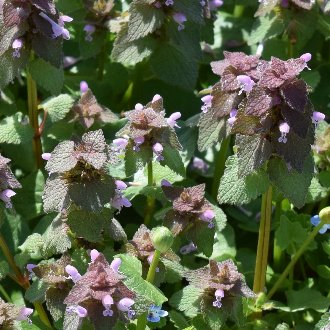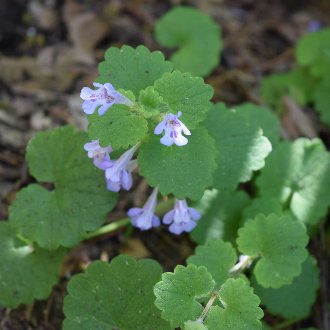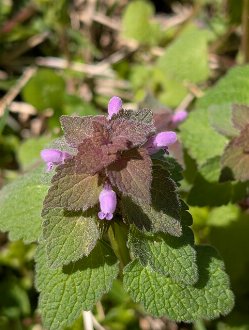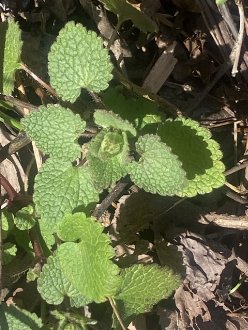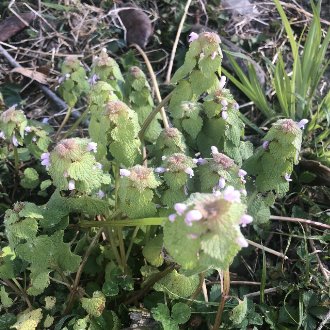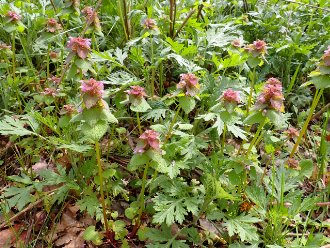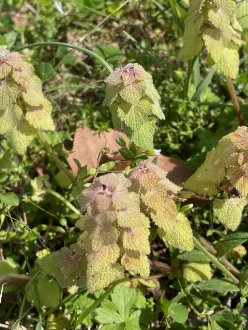Purple Deadnettle (Lamium purpureum L.)
Also known as red deadnettle, red henbit.
↑Summary
A winter annual native to Eurasia and introduced in North America, usually found on rich, moist sites with disturbed soil.
↑Range - Expand
| Legend | Color |
| Introduced | |
| Introduced or Not Present |
This tentative map is based on our own research. It may have limited data on Canada and/or Mexico, and there is some subjectivity in our assignment of plants as introduced vs. expanded. Read more in this blog post.
Although this plant occurs somewhere in each of these regions, it may only occur in a small part of some or all of them.
↑Similar Plants
↑Habitat
Purple deadnettle occurs on sunny to lightly-shaded sites where moist, fertile soil has been exposed from fall into winter. It is most common in anthropogenic habitats, including gardens, nurseries, moist portions of fallow fields, pastures, and cropland where soil has been exposed following harvest, areas along drainage ditches, and patches of moist, fertile soil near buildings. It is also common in degraded natural areas such as small forest fragments and woodland edges, especially in bottomlands or locally-moist sites in uplands. It rarely occurs in undisturbed wild areas.
Purple deadnettle has high moisture and nutrient needs and is usually restricted to soils with abundant organic matter to hold water, usually with a loamy or clay-loam texture, with a pH of only slightly acid, near neutral, or slightly alkaline. It becomes less common in the southeastern coastal plain, where its growth is hindered by the acidic soils. It tolerates a wide range of lighting conditions but needs some direct sun. Because it completes its lifecycle during the dormant season of most deciduous plants, it is largely unaffected by the shade of deciduous trees, but it is usually absent from closed-canopy forests because it cannot germinate in coarse, deep leaf litter.
This plant has taken great advantage of human management of the landscape and is often associated with Western agriculture. In cropland growing warm-season crops, it is often able to complete its lifecycle over the winter without interfering with crop production. Because humans leave it alone in certain types of cropland, its populations surge in agricultural areas. In urban and suburban areas, it benefits from management practices which expose the soil, such as weeding.
It is often able to set seed before mowing and other property management begins in spring, so it is sometimes found in lawns, especially in small patches of grass and at margins of lawns.
It often occurs together with henbit deadnettle (Lamium amplexicaule), which ranges into slightly drier conditions.
↑Life Cycle
This plant is an annual, usually a winter annual, less commonly growing at other times of year.
Seeds usually sprout in fall but the plant remains small. Young plants have rounded leaves of a solid green color, very different from what the plant looks like at maturity. Initially, the plant usually grows out against the ground in a sprawling habit. Unlike many mint-family plants, it does not frequently root at the nodes, instead usually staying connected to its root system only at a single point where the plant sprouted.
The root system is often quite shallow, forming a mat that follows areas of moist, rich soil. The flat growth habit allows this plant to stay covered by snow, preventing water loss during cold, windy weather.
In late winter and early spring, the plant begins growing upright, and the leaves take on a more pointed shape and purplish hue, and it then blooms. Plants usually die down in summer after producing seeds.
Some late-sprouting plants, however, can grow in summer, especially in cooler years. In summer, the plant prefers more shaded, protected, and moist locations than in winter where it can grow in more exposed areas.
Seeds require exposed conditions to germinate. The seeds form a long-term seed bank and may remain dormant for many years until exposed.
↑Faunal Associations
This species does not necessarily attract a large number or diversity of pollinators, and does not need to as it can self-pollinate. Honeybees sometimes visit it, and the large bee-fly (Bombylius major) has been recorded visiting it.
We could not find any reports of Lepidoptera larvae eating this species in North America nor could we find any reports of any other insect herbivores. It is also usually ignored by mammalian herbivores such as rabbits and deer. In general, the Lamium genus is poor at supporting the food web here in North America.
↑Control
This plant can be difficult to completely remove from a site because it has high seed production, tiny seeds, and its seeds can remain viable for many years. It is also abundant in areas where it is established, and its tiny seeds spread readily, leading to a high likelihood of reestablishment. However, reduction strategies can be effective and usually reduce this plant to isolated individuals that can be easily hand-pulled. Control is most effective if surrounding property owners or land managers cooperate and carry out removal at the same time.
Control of this plant must be targetted before it sets seed, as it has a short lifecycle and produces much seed rapidly through self-pollination. Because the bloom time is staggered and can sometimes be irregular, it is safest to remove it before the first blooms appear; waiting until you notice blooms may enable some plants to set seed. Warm spells during winter are often the best time to conduct control. Monitoring the area year-round and acting quickly to pull plants is also important because some plants can occasionally bloom and set seed in fall, or rarely, at other times of year.
Isolated plants can be pulled by hand. Because this plant tends to occur in loose, rich soil and have a shallow, spreading root system, and benefits from soil disturbance, it is important to minimize soil disturbance when pulling it. One hand can grab the base of the plant's stem while the other remains closed under it to keep soil from being pulled up as you pull individual plants. Alternatively, plants can be cut to the base, and will not usually resprout. Although plants are capable of re-rooting, they are fragile and will usually die rapidly if left in place on a dry spot. Cutting to the base is most effective if done right before plants bloom. Larger infestations can be reduced by mowing or weedwhacking right before plants begin to bloom.
Although this plant is vulnerable to numerous herbicides, herbicides can often worsen infestations of this plant by killing non-target species that compete with it and creating more spaces for its seeds to germinate. Herbicides are most suitable for dealing with large infestations on sites where all native plants are fully dormant at the time of application.
This plant can be suppressed by establishing native plants with evergreen or semievergreen basal foliage, which will prevent its germination and establishment, and by minimizing soil disturbance and vegetation-removing disturbance such as mowing or weedwhacking in fall and winter. Thick, coarse, slow-decomposing leaf litter can also inhibit this plant, although it can thrive in faster-decomposing leaf litter as it often has enough space to germinate and can take advantage of the high nutrient availability.
↑Uses
Purple deadnettle is edible, even raw, but it is rarely consumed, in part because the hairs on the plant give in an unappealing texture. Its leaves can also be dried and used to make tea. Its foliage is valuable as a foraged plant because it is available at a time of year where fewer fresh vegetables are available.
Farmers often value purple deadnettle as it covers the soil, preventing erosion during the winter and early spring, before the planting of warm-season crops, and it dies down before the main growing season.
Because it is so abundant around gardens and agriculture, it is rarely cultivated. Rather, these uses lead people to leave it in place, instead of expending resources to control it.
↑Related Plants
There are four other Lamium species, all introduced, that have established in North America. Of these, it is probably closer-related to henbit deadnettle (Lamium amplexicaule) than to yellow archangel (Lamium galeobdolon). The other two species here are white deadnettle (Lamium album) and spotted henbit (Lamium maculatum).
There are numerous other species, both native and introduced, in the broader Lamioideae subfamily.
↑Notes
Although this species is not normally viewed as one of the most-damaging invasive plants due to its tendency to be most common in disturbed, anthropogenic habitats, it does compete directly with native plants. The dominance of it and plants like it in disturbed habitats is likely a factor in which these habitats have much less value to wildlife. Although there is a degree to which ecological restoration work needs to involve reducing the disturbance to ecosystems, the removal or at least reduction of this species and other plants like it might allow more disturbance-loving native plants to take hold in such a way that anthropogenic habitats could have a relatively more-intact food web and better support both native plant populations and wildlife.
↑Links & External Resources
• Lamium purpureum (Purple Dead Nettle) | Illinois Wildflowers (About This Site)
• Lamium purpureum (Purple Deadnettle) | USDA PLANTS Database (About This Site)
• Lamium purpureum | Go Botany (About This Site)
• Lamium purpureum | Biota of North America Project (BONAP) (About This Site)
• Lamium purpureum | NatureServe Explorer (About This Site)
• Lamium purpureum | Missouri Plants (About This Site)
• Purple Deadnettle | Maryland Biodiversity Project (About This Site)
• Lamium purpureum L. (Red Dead-nettle, Purple Dead-nettle) | Digital Atlas of the Virginia Flora (About This Site)



